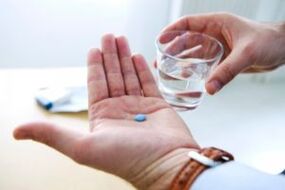Erectile dysfunction is a multifactorial psychosomatic syndrome that occurs in men of any age and is characterized by characteristic symptoms of a decrease in the quality of the erection needed to satisfy sexual desire.
Impotence in men over the age of 50 can be a sign of dysfunction of many organs. Erectile dysfunction significantly reduces a man’s quality of life.
By impotence we mean the inability to achieve a complete and stable erection, the inability to maintain and ensure a successful sexual relationship. The term "impotence" is considered obsolete, but it is still used in everyday life to this day and does not lose its significance.
In urological practice, the term "erectile dysfunction" is commonly used.
Among men, the frequency of potency reduction after 50 years reaches 25%. Erectile dysfunctional complaints peak in the sixth decade.
Causes of low potency and impotence at age 50

Male potency weakens after 50 years for many reasons. Accumulated health problems are manifested not only in the manifestations of cardiovascular, gastrointestinal and joint diseases, but also in the dysfunction of the reproductive system.
The leading causes of decreased potency in men over 50 are vascular disease, mental disorders, and nervous system disease. In addition, in men over the age of 50, prostate adenoma is often considered a cause of erectile dysfunction.
According to international studies, there are several main causes of impotence in older men:
- Vascular disorders: atherosclerosis, arterial hypertension, impaired fat metabolism (elevated cholesterol, low-density lipoprotein, high atherogenic index). These vascular factors lead to abnormal function of the cavernous sinuses of the penis, narrowing of the arteries and veins that prevent normal blood supply, which prevents an erection. In men, normal potency requires dilation of the veins in the cavernous bodies of the penis, which is impossible with vascular pathology, which is determined by elevated blood pressure, atherosclerotic plaques in the abdominal aorta. Progressive varicose veins affecting the pelvic vessels also lead to impotence in men over 50 years of age.
- Neurogenic: central and peripheral. Central ones include parkinsonism, multiple sclerosis, cerebral infarction, epilepsy. Peripheral diseases include pathologies of the nervous system caused by other diseases, especially diabetes, alcoholism, polyneuropathy. These diseases lead to a gradual disruption of the trophism of the genital tissues, to the degenerative processes of the nerve fibers.
- Urological: prostate adenoma, chronic prostatitis.
- Iatrogen due to medical care: damage to the nerves of the rectum, testicles, prostate, bladder during surgery.
- Traumatic: pelvic injuries, damage to the genital arteries, urethra, spinal cord, pelvic fractures.
- Endocrine: obesity, insufficient or excessive thyroid function, type 1 and type 2 diabetes mellitus, pathologies of the pituitary gland, adrenal gland (Itsenko-Cushing's syndrome).
- Medications: taking antihypertensive, antiarrhythmic drugs, diuretics, antidepressants, antiallergics, sedatives, antiandrogens, certain hormonal agents (estrogens, analogues and antagonists of pituitary hormone releasing hormones, antiandrogens).
- Anatomical, i. e. anomalies or diseases of the penis: Peyronie's disease, hypo- and epispadies, penile fracture, severe curvature of the penis.
- Psychological: Violation of sexual arousal due to two types of provocative factors. The generalized type means a complete lack of libido, a violation of intimacy in a relationship. The type of situation means the pronounced effect of stress on a man’s body, his personal relationships with his partner. Situational impotence is usually not a pathology and requires resolution of personal problems, after which erectile function is restored.
As a result of sexual arousal, a nerve impulse along the chains of the reflex of a healthy man leads to a stable erection. This process is based on the release of nitric oxide, the source of which is the cells of the inner lining of the blood vessels of the penis.
For an erection to occur and continue, the nerve impulse must reach the smooth muscle cells that make up the blood vessels in the penis. As a result, the nerve endings interact with the endothelium (the inner layer of the blood vessels) and nitric oxide is released.
Nitric oxide, in turn, activates an enzyme that promotes the release of calcium ions from cells. Smooth muscle cells relax and an erection occurs.
The full functioning of the reflex, which provides normal potency, is possible only if the health of its links is maintained: nerves, blood vessels, endocrine glands.
The pathogenesis of potency disorders in men over the age of 50 is associated with a decrease in the release of nitric oxide from the cells of the blood vessels of the penis. As a result, the cascade of reactions that ensure a complete erection is interrupted.
Many organs and systems are involved in building the normal potency of a 50-year-old man. Many of the diseases that an adult man in his sixties inevitably encounters lead to the loss of one of the links in the reflex that provides potency.
Almost all men experience impotence episodes at the age of 50, however, depending on the severity of the dysfunction of various organs and systems, erectile dysfunction can be situational (temporary) or permanent.
Important
Persistent impotence in a 50-year-old man requires systematic and integrated treatment. A one-sided approach to treating impotence leads to a temporary improvement in the situation.
Diagnosis of impotence

Not all men turn to a urologist and sex therapist to resolve potency problems. Representatives of the stronger sex usually use folk remedies or buy popular therapies on their own to improve potency.
A comprehensive diagnosis of impotence in men over the age of 50 consists of the following steps:
- Ultrasound of the pelvis, including transrectal ultrasound of the prostate, pharmacodopplerography of the vessels of the penis;
- Visual test for erotic stimulation;
- monitoring of penile swelling, including at night;
- palpation of the prostate through the rectum;
- cavernography, spongiography;
- CT and MRI;
- study of the functions of the endothelium of the vessels of the penis (coronary angiography with acetylcholine, examination of the flow-dependent dilatation of the brachial artery in a specimen with its stenosis, examination of laser Doppler flow metrics, tone of peripheral arteries);
- biochemical blood test, glucose tolerance test, blood lipid spectrum assessment;
- Ultrasound of the abdominal organs;
- blood tests for hormones (male and female sex, thyroid and adrenal hormones);
- blood test for prostate-specific antigen;
- examination of the heart and blood vessels (veloEKG, ultrasound).
An important point in diagnosing the causes of impotence in men over 50 is consultation with a sexologist and psychologist. In addition, tests to determine the pathology of potency are widely used and are widely available online, such as ICEF.
How to increase your potential after 50 years

The treatment of impotence in men over the age of 50 is in the vast majority of cases using conservative methods, including drug therapy and psychologist intervention.
Above all, successful treatment of impotence in mature men requires the greatest possible cure or recovery of diseases of the heart and blood vessels, endocrine system, liver, kidneys, and bladder. and prostate gland.
The effectiveness of 50-year-old men free of chronic visceral pathologies can be corrected with popular tools - phosphodiesterase inhibitors (PDEs).
In male sexual pathology, PDE inhibitors are the most effective and fastest acting drugs. These include the following funds:
- vardenafil - duration of action 5-12 hours;
- sildenafil - duration of action 4 hours;
- tadalafil - duration of action 36 hours.
The medication is used one hour (half an hour) before intercourse. You should know that it takes minimal excitement to get an erection when it is based on this group. The dose can be reduced to 50 mg on average, but can be reduced to 25 mg or increased to 100 mg at a time.
However, such drugs have a fairly wide range of side effects on the lungs and heart because the drug does not only affect the endothelium of the blood vessels in the penis.
In men, after 50 years, the increase in potency with PDE inhibitors can be achieved by influencing the main mechanism of the pathogenesis of erectile dysfunction: an increase in nitric oxide concentration. In addition to this class of agents, NO synthase activators are also used to increase the nitric oxide content.
Many men are worried about whether alcohol can relax and increase the chances of a stable erection, how to increase potency after 50 years with medication, and whether it can be combined with alcohol.
If a man does not abuse alcohol and does not suffer from severe cardiovascular pathologies, the potency-enhancing popular devices can be taken with alcohol.
In addition to PDE inhibitors, popular treatments for impotence include:
- Testosterone devices. Restoration of potency in men After 50-60 years, when testosterone production in the testes decreases, male sex hormone preparations can be used.
- Prostaglandins, which are injections into the tissues of the penis. Improves blood flow, normalizes blood supply to veins and arteries.
- Alpha-blockers whose effect is based on dilating the blood vessels in the penis and pelvis.
Potency can be increased in combination with folk remedies such as Eleutherococcus, Ginseng, Aralia, pumpkin seeds, nuts, celery, honey, ginger. In addition, dietary supplements are widely used.
Because it is quite difficult to improve potency after 50 years in the presence of chronic diseases, the use of additional physiotherapy methods, especially acupuncture, electrophoresis is recommended.
Potency can also be increased by mechanical means, especially with a vacuum pump for the penis.
The fight against obesity and alcohol dependence is important in the treatment of impotence.
As is well known, fat cells in men’s bodies are considered a source of female sex hormone, which disrupts hormonal balance, leading to prostate pathologies and sexual dysfunction. The source of natural estrogens is beer. A man over the age of 50 should drink beer no more than once a week.
You need to lose weight gradually, losing up to 5 kg per month. Moderate exercise and diet are recommended. Intense, spontaneous and sudden workouts in the gym do not lead to the restoration of potency, but only aggravate the situation.
The dosing approach to dynamic loads, nutritional correction, allows you to overcome impotence without damaging the body.















































